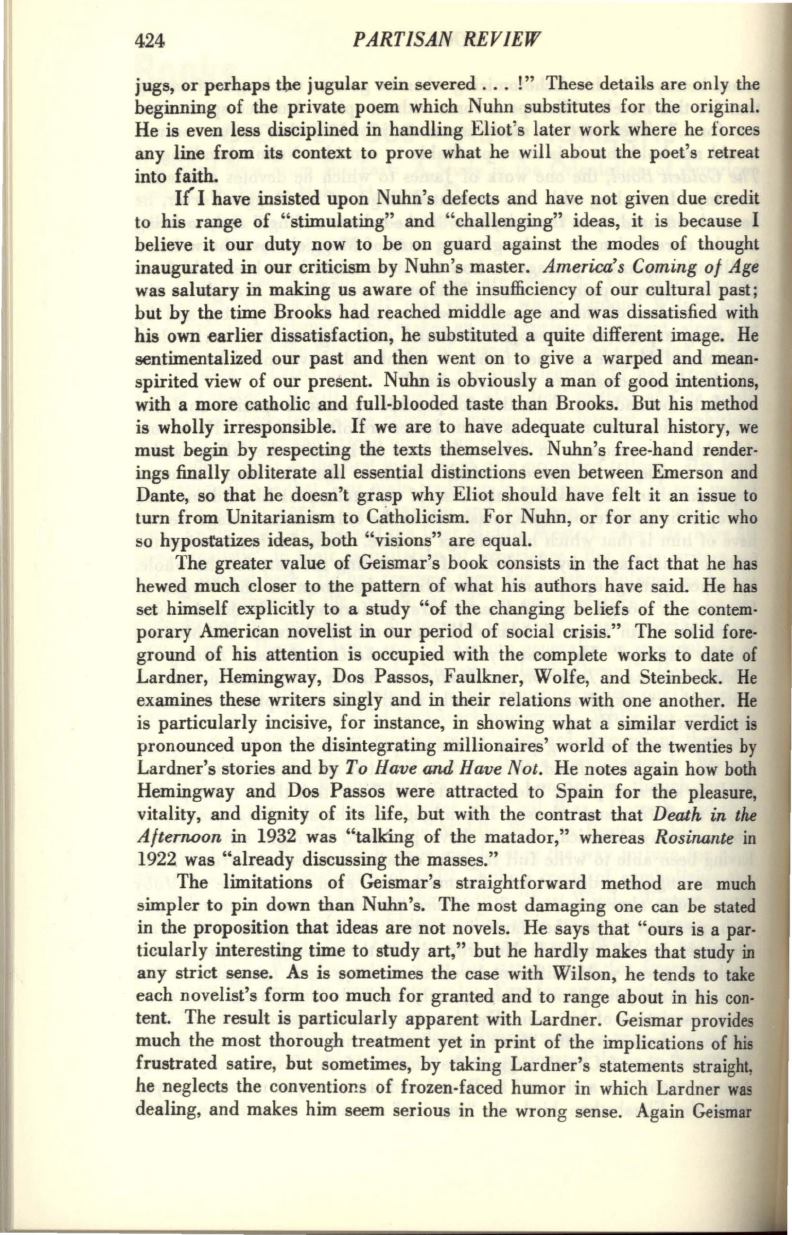
424
PARTISAN REVIEW
jugs, or perhaps the jugular vein severed ...
!"
These details are only the
beginning of the private poem which Nuhn substitutes for the original.
He is even less disciplined in handling Eliot's later work where he forces
any line from its context to prove what he will about the poet's retreat
into faith.
I(I have insisted upon Nuhn's defects and have not given due credit
to his range of "stimulating" and "challenging" ideas, it is because I
believe it our duty now to he on guard against the modes of thought
inaugurated in our criticism by Nuhn's master.
America's Coming of Age
was salutary in making us aware of the insufficiency of our cultural past;
hut by the time Brooks had reached middle age and was dissatisfied with
his own earlier dissatisfaction, he substituted a quite different image. He
sentimentalized our past and then went on to give a warped and mean·
spirited view of our present. Nuhn is obviously a man of good intentions,
with a more catholic and full-blooded taste than Brooks. But his method
is wholly irresponsible.
If
we are to have adequate cultural history, we
must begin by respecting the texts themselves. Nuhn's free-hand render·
ings finally obliterate all essential distinctions even between Emerson and
Dante, so that he doesn't grasp why Eliot should have felt it an issue to
turn from Unitarianism to Catholicism. For Nuhn, or for any critic who
so hypostatizes ideas, both "visions" are equal.
The greater value of Geismar's hook consists in the fact that he has
hewed much closer to the pattern of what his authors have said. He has
set himself explicitly to a study "of the changing beliefs of the contem·
porary American novelist in our period of social crisis." The solid fore·
ground of his attention is occupied with the complete works to date of
Lardner, Hemingway, Dos Passos, Faulkner, Wolfe, and Steinbeck. He
examines these writers singly and in their relations with one another. He
is particularly incisive, for instance, in showing what a similar verdict is
pronounced upon the disintegrating millionaires' world of the twenties by
Lardner's stories and by
To Have and Have Not.
He notes again how both
Hemingway and Dos Passos were attracted to Spain for the pleasure,
vitality, and dignity of its life, hut with the contrast that
Death in
the
Afternoon
in 1932 was "talk"mg of the matador," whereas
Rosinante
in
1922 was "already discussing the masses."
The limitations of Geismar's straightforward method are much
simpler to pin down than Nuhn's. The most damaging one can he stated
in the proposition that ideas are not novels. He says that "ours is a par·
ticularly interesting time to study art," hut he hardly makes that study
in
any strict sense. As is sometimes the case with Wilson, he tends to take
each novelist's form too much for granted and to range about in his con·
tent. The result is particularly apparent with Lardner. Geismar provides
much the most thorough treatment yet in print of the implications of his
frustrated satire, hut sometimes, by taking Lardner's statements straight,
he neglects the conventions of frozen·faced humor in which Lardner
was
dealing, and makes him seem serious in the wrong sense. Again Geismar


